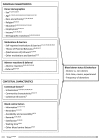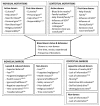Individual, contextual and network characteristics of blood donors and non-donors: a systematic review of recent literature
- PMID: 28686151
- PMCID: PMC5589701
- DOI: 10.2450/2017.0064-17
Individual, contextual and network characteristics of blood donors and non-donors: a systematic review of recent literature
Abstract
Background: The ageing population and recent migration flows may negatively affect the blood supply in the long term, increasing the importance of targeted recruitment and retention strategies to address donors. This review sought to identify individual, network and contextual characteristics related to blood donor status and behaviour, to systematically discuss differences between study results, and to identify possible factors to target in recruitment and retention efforts.
Methods: The systematic review was conducted in accordance with a predefined PROSPERO protocol (CRD42016039591). After quality assessments by multiple independent raters, a final set of 66 peer-reviewed papers, published between October 2009 and January 2017, were included for review.
Results: Individual and contextual characteristics of blood donor status and behaviour were categorised into five main lines of research: donor demographics, motivations and barriers, adverse reactions and deferral, contextual factors, and blood centre factors. Results on donor demographics, motivations and barriers, and contextual factors were inconclusive, differing between studies, countries, and sample characteristics. Adverse reactions and deferral were negatively related to blood donor behaviour. Blood centre factors play an important role in donor management, e.g., providing information, reminders, and (non-)monetary rewards. No studies were found on network characteristics of (non-)donors.
Discussion: Although individual and contextual characteristics strongly relate to blood donor status and behaviour, mechanisms underlying these relations have not been studied sufficiently. We want to stress the importance of longitudinal studies in donor behaviour, exploring the role of life events and network characteristics within blood donor careers. Increased understanding of donor behaviour will assist policy makers of blood collection agencies, with the ultimate goal of safeguarding a sufficient and matching blood supply.
Conflict of interest statement
The Authors declare no conflicts of interest.
Figures



References
-
- Sanquin. Sanquin annual report 2015. [Accessed on 04/06/2016]. Available at: http://2015.annualreportsanquin.nl/
-
- Verdecchia NM, Wisniewski MK, Waters JH, et al. Changes in blood product utilization in a seven-hospital system after the implementation of a patient blood management program: a 9-year follow-up. Hematology. 2016;21:490–9. - PubMed
-
- Williams SCP. Stanford Medicine. Stanford University School of Medicine; [Accessed on 01/11/2016]. Against the flow: what’s behind the decline in Blood Transfusions? Available at: http://sm.stanford.edu/archive/stanmed/2013spring/article5.html.
-
- Atsma F, Veldhuizen IJT, De Vegt F, et al. Cardiovascular and demographic characteristics in whole blood and plasma donors: results from the Donor InSight Study. Transfusion. 2011;51:412–20. - PubMed
Publication types
MeSH terms
LinkOut - more resources
Full Text Sources
Medical
